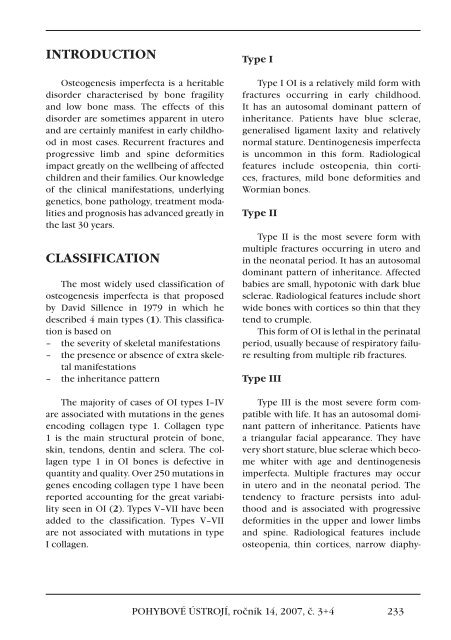Ortopedická protetika Praha sro - Společnost pro pojivové tkáně
Ortopedická protetika Praha sro - Společnost pro pojivové tkáně
Ortopedická protetika Praha sro - Společnost pro pojivové tkáně
You also want an ePaper? Increase the reach of your titles
YUMPU automatically turns print PDFs into web optimized ePapers that Google loves.
INTRODUCTION<br />
Osteogenesis imperfecta is a heritable<br />
disorder characterised by bone fragility<br />
and low bone mass. The effects of this<br />
disorder are sometimes apparent in utero<br />
and are certainly manifest in early childhood<br />
in most cases. Recurrent fractures and<br />
<strong>pro</strong>gressive limb and spine deformities<br />
impact greatly on the wellbeing of affected<br />
children and their families. Our knowledge<br />
of the clinical manifestations, underlying<br />
genetics, bone pathology, treatment modalities<br />
and <strong>pro</strong>gnosis has advanced greatly in<br />
the last 30 years.<br />
CLASSIFICATION<br />
The most widely used classification of<br />
osteogenesis imperfecta is that <strong>pro</strong>posed<br />
by David Sillence in 1979 in which he<br />
described 4 main types (1). This classification<br />
is based on<br />
– the severity of skeletal manifestations<br />
– the presence or absence of extra skeletal<br />
manifestations<br />
– the inheritance pattern<br />
The majority of cases of OI types I–IV<br />
are associated with mutations in the genes<br />
encoding collagen type 1. Collagen type<br />
1 is the main structural <strong>pro</strong>tein of bone,<br />
skin, tendons, dentin and sclera. The collagen<br />
type 1 in OI bones is defective in<br />
quantity and quality. Over 250 mutations in<br />
genes encoding collagen type 1 have been<br />
reported accounting for the great variability<br />
seen in OI (2). Types V–VII have been<br />
added to the classification. Types V–VII<br />
are not associated with mutations in type<br />
I collagen.<br />
Type I<br />
Type I OI is a relatively mild form with<br />
fractures occurring in early childhood.<br />
It has an autosomal dominant pattern of<br />
inheritance. Patients have blue sclerae,<br />
generalised ligament laxity and relatively<br />
normal stature. Dentinogenesis imperfecta<br />
is uncommon in this form. Radiological<br />
features include osteopenia, thin cortices,<br />
fractures, mild bone deformities and<br />
Wormian bones.<br />
Type II<br />
Type II is the most severe form with<br />
multiple fractures occurring in utero and<br />
in the neonatal period. It has an autosomal<br />
dominant pattern of inheritance. Affected<br />
babies are small, hypotonic with dark blue<br />
sclerae. Radiological features include short<br />
wide bones with cortices so thin that they<br />
tend to crumple.<br />
This form of OI is lethal in the perinatal<br />
period, usually because of respiratory failure<br />
resulting from multiple rib fractures.<br />
Type III<br />
Type III is the most severe form compatible<br />
with life. It has an autosomal dominant<br />
pattern of inheritance. Patients have<br />
a triangular facial appearance. They have<br />
very short stature, blue sclerae which become<br />
whiter with age and dentinogenesis<br />
imperfecta. Multiple fractures may occur<br />
in utero and in the neonatal period. The<br />
tendency to fracture persists into adulthood<br />
and is associated with <strong>pro</strong>gressive<br />
deformities in the upper and lower limbs<br />
and spine. Radiological features include<br />
osteopenia, thin cortices, narrow diaphy-<br />
POHYBOVÉ ÚSTROJÍ, ročník 14, 2007, č. 3+4 233

















